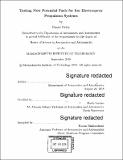| dc.contributor.advisor | Paulo Lozano. | en_US |
| dc.contributor.author | Getty, Daniel (Daniel E.) | en_US |
| dc.contributor.other | Massachusetts Institute of Technology. Department of Aeronautics and Astronautics. | en_US |
| dc.date.accessioned | 2019-02-14T15:51:10Z | |
| dc.date.available | 2019-02-14T15:51:10Z | |
| dc.date.copyright | 2018 | en_US |
| dc.date.issued | 2018 | en_US |
| dc.identifier.uri | http://hdl.handle.net/1721.1/120433 | |
| dc.description | Thesis: S.M., Massachusetts Institute of Technology, Department of Aeronautics and Astronautics, 2018. | en_US |
| dc.description | Cataloged from PDF version of thesis. | en_US |
| dc.description | Includes bibliographical references (pages 73-75). | en_US |
| dc.description.abstract | Electrospray thrusters are a class of electric propulsion that extract and accelerate ions from the surface of an electrically conductive liquid surface. This liquid surface is that of an ionic liquid, a room temperature molten salt, applied to a porous substrate. The substrate is etched via laser to form a field enhancing structure off of which ions will be evaporated. This research expands on the field in two separate ways. First, it implements and evaluates a carbon xerogel emitter substrate as an alternative over current glass emitters. This substrate was found to fire stably and with higher stable currents than the glass alternative (1.5 - 2 times the maximum stable current). In addition, this work analyzes and evaluates two new high conductivity ionic liquid propellants, EMI-(HF)F and S111-(HF)F. Improvements or disadvantages of EMI- (HF)F over the current baseline of EMI-CF₃BF₃ were inconclusive. S111-(HF)F, however, showed a distinct improvement in specific impulse over EMI-CF₃BF₃ (3160 ± 290 s vs. 2140 ± 130 s) without a statistically significant drop in total efficiency. Future work could include the collection of time of flight data in the negative firing mode, as well as higher precision retarding potential data in both positive and negative polarities. Additional measures could also be taken to decrease the spacing between emitter tips on the carbon substrate, thereby increasing the current and thrust density of the thrusters. | en_US |
| dc.description.statementofresponsibility | by Daniel Getty. | en_US |
| dc.format.extent | 75 pages | en_US |
| dc.language.iso | eng | en_US |
| dc.publisher | Massachusetts Institute of Technology | en_US |
| dc.rights | MIT theses are protected by copyright. They may be viewed, downloaded, or printed from this source but further reproduction or distribution in any format is prohibited without written permission. | en_US |
| dc.rights.uri | http://dspace.mit.edu/handle/1721.1/7582 | en_US |
| dc.subject | Aeronautics and Astronautics. | en_US |
| dc.title | Testing new potential fuels for ion electrospray propulsion systems | en_US |
| dc.type | Thesis | en_US |
| dc.description.degree | S.M. | en_US |
| dc.contributor.department | Massachusetts Institute of Technology. Department of Aeronautics and Astronautics | |
| dc.identifier.oclc | 1084486202 | en_US |
